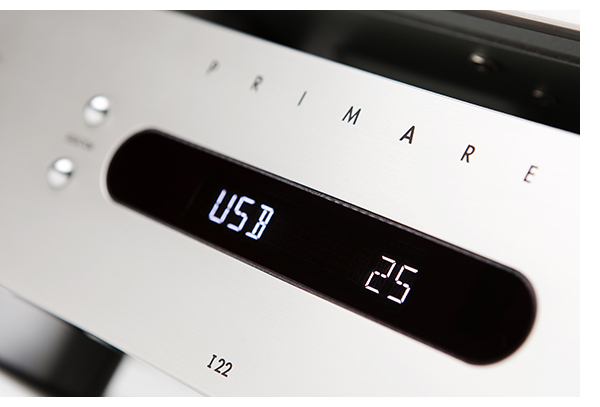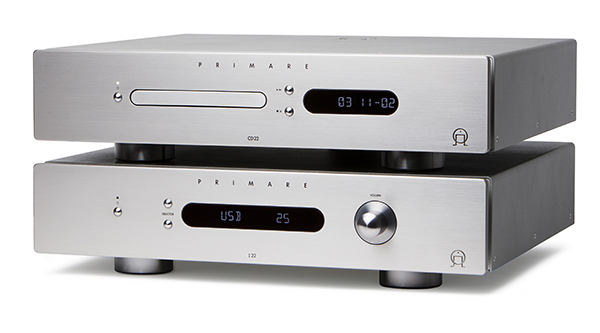 Incorporating a DAC inside an integrated amplifier has been going on for some time now, with mixed results, and the Primare I22 is a product arguably aimed more at the music lover who likes to keep things simple.
Incorporating a DAC inside an integrated amplifier has been going on for some time now, with mixed results, and the Primare I22 is a product arguably aimed more at the music lover who likes to keep things simple.
The I22 pictured here includes the $799 DAC board (with 24/96 USB and 24/192 Toslink and SPDIF inputs) for $2,498. Those of you already in possession of a good DAC can order your I22 without DAC for $1,799 and those on the fence can add the board later for $799, without a huge financial penalty.
While aimed at a consumer who will probably spend $1,000 – $4,000 on a pair of speakers to round out a system, the I22 is well at home driving the $35,000 KEF Blades. Its 80 watts per channel prove more than adequate to really rock the orange KEF flagship speakers.
Taking advantage of Primare’s UFPD (Ultra Fast Power Device) technology, which combines the Class D amplification stage and output filters into a single device, the claimed sonic improvements are readily apparent: This is a thoroughly modern Class D design, which suffers from none of the sonic artifacts that characterize (and often plague) this configuration.
Listening to the multi-layered vocals of 10cc’s “Marriage Bureau” is a treat – all of the late ’70s multitrack wizardry is in full effect, including the great Moog synthesizer tracks, with everything well sorted and keeping its own distinct sonic space.
 The ins and outs
The ins and outs
The front panel is the essence of understatement, with a single volume control, flanked by a pale white LED indicator panel, displaying the input in use along with the volume level. Just to the right is a pair of small, machined buttons to select input, and one more to switch between standby and power-on mode. Incidentally, this might be counterintuitive to some, as the LED glows when the I22 is in standby mode, extinguishing when the amplifier is on.
Inputs 1-5 are standard line level inputs with RCA jacks and inputs 6–8 are digital inputs (if you’ve had the DAC board installed), with a Toslink, USB and SPDIF. For the duration of the review, we used the Meridian Control 15 server via SPDIF and the Aurender A10 server via USB. The majority of the files used were 16 bit/44.1, with a bit of dallying into the world of high res. Hardcore audiophiles might squeal about the lack of 24/192 USB capability (or DSD for that matter, but I’m not the least bit concerned); however, for those streaming files from a laptop or other digital source, primarily of CD and MP3 quality, the I22 will be just fine as it is. Should the highest resolution digital files be your priority, order the I22 without the DAC board, or just use an SPDIF converter with your laptop. Pairing a Mac Book Pro with the M-Tech USB converter recently reviewed worked perfectly, requiring only a minimal investment of $179.
Setup takes but a second to unbox; connect speakers and source and you’re rocking – it couldn’t be easier. Though it might not be important to some, the I22 is lusciously understated and feels considerably more expensive than its modest price tag might suggest.
 Like every other Class D amplifier we’ve tested, the I22 does respond incredibly well to an upgraded power cord and line conditioning. Adding a power cord and the EVO 3 line conditioner from ISO TEK removes a layer of glare and cloudiness that you might mistake for the sonic signature of the amplifier, giving the I22 an even smoother, more natural sound.
Like every other Class D amplifier we’ve tested, the I22 does respond incredibly well to an upgraded power cord and line conditioning. Adding a power cord and the EVO 3 line conditioner from ISO TEK removes a layer of glare and cloudiness that you might mistake for the sonic signature of the amplifier, giving the I22 an even smoother, more natural sound.
Resolution without regret
Both Carole King’s Tapestry and Daft Punk’s Random Access Memories, downloaded via HD Tracks easily illustrate the onboard DACs ability to resolve the difference between standard and high-resolution files. An even better demo was evident with Roberta Flack and Donny Hathaway’s self-titled album, also in 24/192. Both vocalists occupied their own space, delicately layered upon each other, with a delightful smoothness – again offering higher than expected for the price asked.
The deep low-frequency content in the Daft Punk album focuses on a primary strength of Class D amplifiers – bass response, providing equally solid heft and control. This is very impressive with the KEF Blades, but even more so with the $1,499/pair LS-50s which really come alive via the I22, exhibiting tremendous LF response.
Equally compelling is the rendition of analog tracks, captured to 24/96, via my Nagra LB studio recorder, using the AVID Acutus Reference SP/Lyra Atlas/Indigo Qualia analog front end. Again, resolution takes a big jump for the better, i.e. more natural, underscoring the overall sonic performance of the onboard DAC. Sifting through a series of recent digital captures from the Music Matters Jazz Blue Note catalog makes it even easier to listen to the amount of texture the I22 is capable of rendering when the source material is up to the task.
Finally, combining a Rega RP6 turntable and Exact cartridge via the latest tube phonostage from Monk Audio (12AX7 powered, $1,195 MSRP) rounds the system out nicely for those wanting to make the foray into analog without breaking the bank. Spinning Daniel Lanois’s Black Dub album, chock full of acoustic and electronic texture, proves how smooth this amplifier is capable of sounding. While you wouldn’t mistake it for a valve amplifier, it is in no way harsh; in fact, a number of audiophile buddies didn’t know it was a Class D design until it was revealed.
The second track on the Lanois album, “I Believe In You,” features some great drum sounds, that are all captured with excellent depth, texture, speed and delicacy – especially with the brush work via drummer Brian Blades. Many Class D designs have a tendency to sound somewhat thin in the sense of a two dimensional soundstage, yet here the Primare does very well. Lead vocalist Trixie Whitley has always stood out in front of the soundstage, as she does on my reference system. Comparing this to a somewhat similarly priced PrimaLuna tubed integrated, the tubes definitely throw a more three dimensional soundfield, but in comparison to similarly priced solid state kit, the I22 more than holds its own. And you don’t have to screw around with vacuum tubes, either.
 Simple, stylish, sonic excellence
Simple, stylish, sonic excellence
Those wanting bells and whistles should look elsewhere. However, if you want great sound wrapped in an understated enclosure that will not call much attention to itself, I can’t think of a better choice than the Primare I22. Now, the only thing you need decide is if you want it in silver or black, and whether you’d like the DAC board or simply use the matching (and equally enticing) C22 CD player. We are very happy to award this amplifier one of our Exceptional Value Awards for 2013 – even more so, with the DAC installed.
The Primare I22 Integrated Amplifier
MSRP: $1,799
$2,498 (with DAC)
www.primare.net (factory)
www.vanaltd.com (US Distributor)
Peripherals
Digital Sources Meridian Control 15, Aurender S10, MacBook Pro
Analog Source Rega RP6/Exact Cartridge, Monk Audio Phonostage
Speakers KEF LS50, KEF Blade, Harbeth Compact 7
Cable Cardas Clear Light
Accessories IsoTek Evo 3 power conditioner, power cord.



















